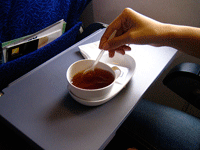At 30,000 feet, the altitude takes its toll on the human body. Below are some handy tips that should ensure you arrive in your destination in tip-top, if not, more cheerful form.
 1. DRINK PLENTY OF LIQUIDS. Air humidity falls to approximately 6 percent in airplane cabins, which severely lowers the body’s water supply.
1. DRINK PLENTY OF LIQUIDS. Air humidity falls to approximately 6 percent in airplane cabins, which severely lowers the body’s water supply.
Tip: Tomato juice and green tea are good choices as they keep the digestive system functioning without using up the body’s water supply.
Avoid: Carbonated "fizzy" drinks, alcohol and caffeine, which quickly dehydrate the body. Moreover, caffeine disturbs the body's circadian rhythm, further aggravating jet lag.
2. EAT LIGHT. Increased air pressure at high altitude expands gases in the body, making digestion much harder.
Tip: Munching on fruits prevents gas build up and helps hydrate the body. However, make sure you eat something during the flight so that your body can begin synchronising to the local time at your destination. This will minimise the effects of jet lag.
Avoid: "Gassy" foods, such as lentils, beans, cabbage. Stay away from starchy foods like potatoes and too much pasta.
 3. MOISTURISE. Low humidity causes the body to absorb fluids faster, leaving your skin and eyes dry
3. MOISTURISE. Low humidity causes the body to absorb fluids faster, leaving your skin and eyes dry
Tip: For long-haul flights, apply a thicker moisturiser, such as body lotion, onto the face to lock in the water longer. Carry a small bottle of eyedrops (3.4oz or less) in your hand carry. Apply plenty of lip balm to prevent lips from cracking.
Avoid: Steer clear from caffeine, carbonated drinks and alcohol as these only exacerbate dehydration.
4. PERFORM IN-SEAT EXERCISES. The risk of Deep Vein Thrombosis (DVT) triples on long-haul flights because of lack of movement.
Tip: Try sitting on an aisle seat as it will encourage you to walk around more and stretch your legs. Walk around the aircraft and carry out leg exercises.
Avoid: Sitting cross legged will not only give you pins and needles but also increases the risk of DVT. 5. ADJUST TO THE LOCAL TIME. There are several symptoms that people do not generally associate with jet lag, such as irritability, headaches and sometimes even mild depression.
5. ADJUST TO THE LOCAL TIME. There are several symptoms that people do not generally associate with jet lag, such as irritability, headaches and sometimes even mild depression.
Tip: Let your body clock quickly adapt to the local time at destination even while on mid-flight. Look out the window frequently to capture natural light as an indicator to the body of what time zone it should be functioning in. On arrival, take a walk around to get your body clock back in sync.
Avoid: Stay awake on Eastward bound flights so that when you arrive, you can fall asleep according to the local time.
6. CHOOSE A SEAT LEAST AFFECTED BY TURBULENCE. Motion sickness is triggered by a disturbance of the inner ear because of repeated motion. It can cause dizziness, sweating or nausea.
Tip: Opt for a seat where there is the least motion, preferably the middle seat by the wings of the plane. If available, try drinking hot ginger or peppermint tea to reduce nausea. If symptoms are bad, see a doctor before your flight to get a prescription for motion sickness.
Avoid: Overeating, especially greasy or gassy food as these together with the high altitude may cause bloatedness and discomfort.
7. BOOST YOUR IMMUNE SYSTEM. According to the UK Civil Aviation Authority, 50 percent of air in the plane is recycled, including the bacteria, viruses and germs floating around. .
Tip: Take a few Vitamin C pills to avoid catching the bug. Get plenty of exercise before the flight. This gets the blood circulating properly, thus improving the immune system and reducing DVT.
Avoid: Alcohol before and during the flight as this suppresses the immune system.
Erica Rae Chong








